Lascaux Cave
Online Biology Dictionary
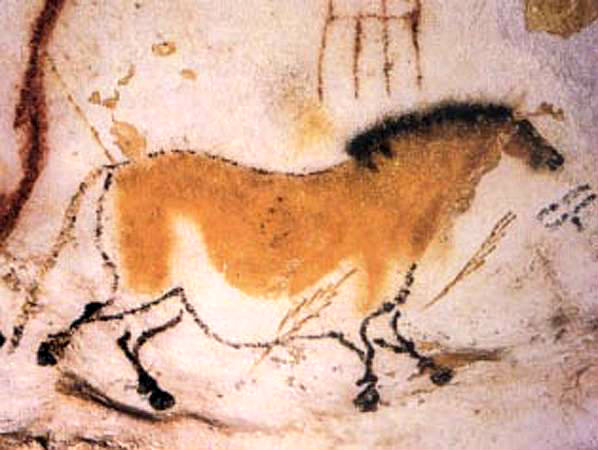 The Second Chinese Horse, Lascaux Cave.
The Second Chinese Horse, Lascaux Cave.
|
|
EUGENE M. MCCARTHY, PHD
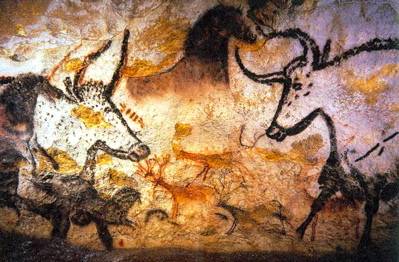 Two aurochs facing off in the Hall of Bulls. Note additional, smaller figures. Image courtesy of Prof. Saxx
Two aurochs facing off in the Hall of Bulls. Note additional, smaller figures. Image courtesy of Prof. Saxx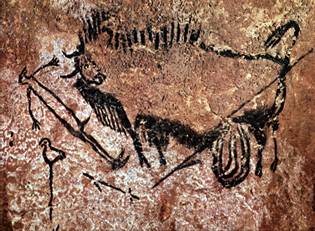 The Wounded Man, Lascaux. Image: Peter80)
The Wounded Man, Lascaux. Image: Peter80)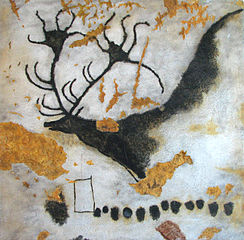 Black Stag (Lascaux), probably a representation of the now extinct giant deer Megalaceros, below
Black Stag (Lascaux), probably a representation of the now extinct giant deer Megalaceros, below 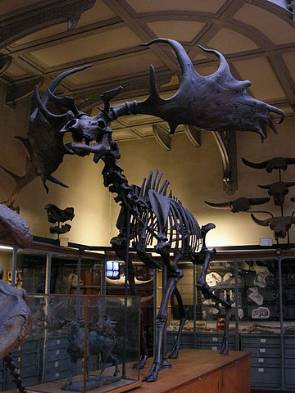 The extinct giant deer Megaloceros giganteus, Museum d'Histoire Naturelle, Paris. (Enlarged image)
The extinct giant deer Megaloceros giganteus, Museum d'Histoire Naturelle, Paris. (Enlarged image)
This complex of subterranean chambers is one of the most elaborately painted caverns known. Located in southwestern France, it was discovered on September 12, 1940 by four teenage boys, Georges Agnel, Jacques Marsal, Marcel Ravidat and Simon Coencas, who entered the cave via a long shaft and found that the walls of the cave were covered with paintings of game animals.
The paintings, of which there are nearly 2,000, are about 17,000 years old, dating to the late Paleolithic. About half represent large game animals — aurochs, bison, horses and stags — many of which seem frozen in rapid motion.
One painting at Lascaux, in the Shaft of the Wounded Man, depicts a humanlike figure (see right), which is unusual in a cave painting. This is the only representation of a human being in the entire cave. The bison, which seems about to charge, has been struck by a spear and partially disemboweled. Note the bird on a stick. In many primitive societies, birds were assigned the role of psychopomp (conductor of souls to the afterlife). All of the drawings in the Shaft are executed in manganese dioxide, a black pigment.
The various chambers of the cavern are named: the Great Hall of the Bulls, the Axial Gallery, the Painted Gallery, the Chamber of Engravings, the Lateral Passage, the Shaft of the Wounded Man, and the Chamber of Felines.
When the caverns were opened to the public, beginning in 1948, changes in the atmosphere began to damage the paintings, and a black mold began to spread throughout the cave. By the mid-fifties, these changes had become obvious. As a result Lascaux was closed in 1963. The paintings were restored to their original state, but the cave is now open only to conservators and a few experts. However, a full-scale replica cave, Lascaux II, has been built nearby so all the paintings can still be viewed, fake though they may be.
Most shared on Macroevolution.net:
Human Origins: Are we hybrids?
On the Origins of New Forms of Life
Mammalian Hybrids
Cat-rabbit Hybrids: Fact or fiction?
Famous Biologists
Dog-cow Hybrids
Georges Cuvier: A Biography
Prothero: A Rebuttal
Branches of Biology
Dog-fox Hybrids